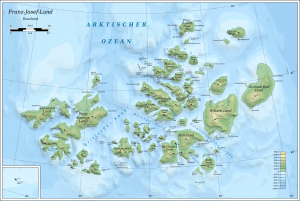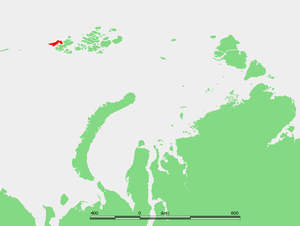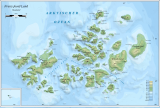Alexandraland
| Alexandraland | ||
|---|---|---|
| Map of the Franz Josef Land | ||
| Waters | Arctic Ocean | |
| Archipelago | Franz Josef Land | |
| Geographical location | 80 ° 38 ′ N , 46 ° 35 ′ E | |
|
|
||
| length | 70 km | |
| width | 30 km | |
| surface | 1 095.3 km² | |
| Highest elevation | Kupol Lunny (Kropotkina Ice Cap) 382 m |
|
| Residents | 5 ward staff (winter) (2007) <1 inh / km² |
|
| main place | Nagurskaya | |
| Location of Alexandraland | ||
Alexandra Land ( Russian Земля Александры , Zemlya Alexandry ) is - if distant areas of Victoria Island no longer to count - the westernmost island of the to Russia belonging to Franz-Josef-Lands in the Arctic Ocean .
geography
Alexandraland, including the northeastern peninsula Polyarnych Lettschikow ( Полуостров Полярных Летчиков ) is around 70 km long and a maximum of 30 km wide. The peninsula is connected to the main part of the island by a 3.1 km wide land bridge.
With an area of around 1095 km², Alexandraland is the fourth largest island in Franz-Josef-Land (after Prinz-Georg-Land , Wilczek-Land and Graham-Bell-Insel ); its highest point, the Kupol Lunny ice cap ( Купол Лунный ), is given at 382 meters above sea level. It is separated by the Cambridge Canal from Prince George Land to the east, the largest island in the archipelago, and only six kilometers away from it in the north. 157 km further west, outside the Franz-Josef-Land, is the isolated Victoria Island . In the north of the island is the Russian polar base Nagurskaja , the northernmost place in Russia.
history
It is believed that the island was sighted by the Norwegian walrus hunter Nils Rønnbeck in 1865 . Officially, however, the British polar explorer Benjamin Leigh Smith is the discoverer of the island, who named it in 1880 after Princess Alexandra of Denmark , wife of Albert Eduard of Saxe-Coburg and Gotha, who later became King Edward VII of Britain .
In the spring of 1897, the Jackson Harmsworth Expedition, led by Frederick George Jackson, explored the island by dog sledding. Jackson found out that the neighboring Prinz-Georg-Land was an island of its own. Jackson had mapped the island's south coast as early as 1895.
In July 1914, Valerian Ivanovich Albanov , navigator of the Svyataja Anna , reached land here for the first time with nine comrades after months of marching through the pack ice. Only Albanov and the sailor Alexander Konrad managed to get to Northbrook Island , where they were rescued by the Sedov expedition in August . They were the only survivors of a Russian expedition that began in 1912 under Georgi Lwowitsch Brusilov .
In 1928, several rescue expeditions searched the island for survivors of Umberto Nobiles Italia expedition. Two years later, the Norwegian Gunnar Horn briefly landed on the island.
During the Second World War , the German "Schatzgräber" weather troop set up a weather station on Alexandraland in September 1943 . 10 men were brought on board the weather research vessel Kehdingen under the escort of U 387 to the east coast of the island. In May 1944 the station was supplied from the air. A short time later, however, most of the relatives contracted trichinosis from eating raw polar bear meat . In July 1944 the station was evacuated. In October 1944 U 387 was sent again to Alexandraland to set up an automatic weather station there, but it could not reach the island due to thick pack ice.
The runway built by the German soldiers was incorporated into the Nagurskaya military base by the Soviet Union in 1952 . The station is still operated today as the only one in all of Franz-Joseph-Land . In October 2015, the Russian Defense Ministry announced that it was 97% ready to set up a military base on the site in which 150 soldiers could live self-sufficient for over 18 months. The military base is 14,000 m². With the increased military presence, Russia would like to underpin its claim to arctic areas, in which, according to its own information, 4.9 billion tons of fossil fuels are suspected. In addition, the Franz-Josef-Land could acquire more economic and strategic importance after the increasing melting of the pack ice, since the freight traffic between the Atlantic and the Pacific can be handled by the Arctic Ocean.
literature
- Mills, William J .: Exploring Polar Frontiers: A Historical Encyclopedia. ABC-Clio, Santa Barbara 2003. ISBN 978-1576074220 , p. 10




